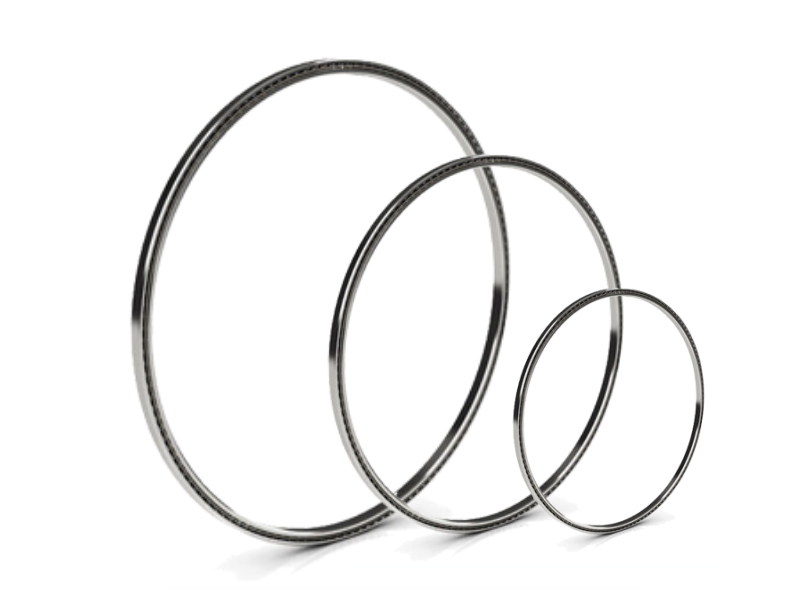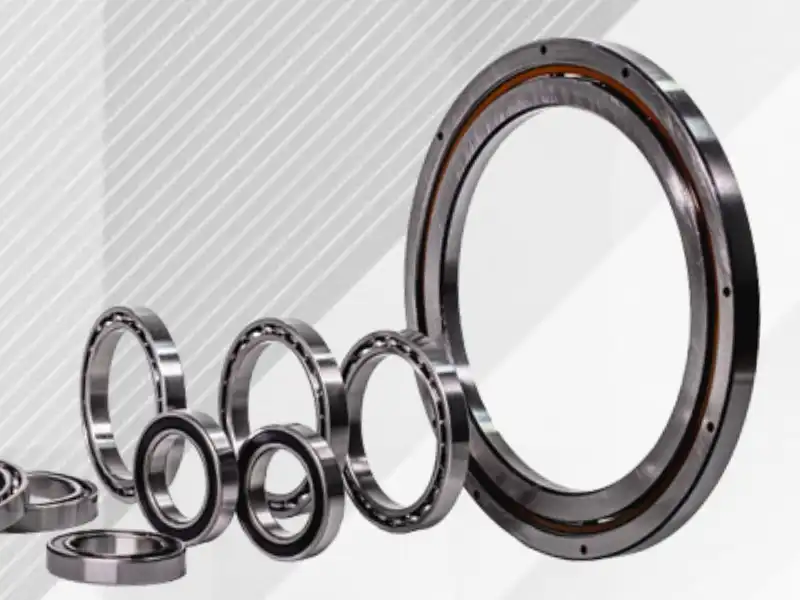What is a Thin Section Angular Contact Bearing?
Thin section angular contact bearings represent a specialized class of precision bearings designed to provide optimal performance in applications where space is limited but accuracy is paramount. These bearings feature a distinctive design that combines the compact profile of thin section bearings with the directional load-handling capabilities of angular contact configurations, making them invaluable in various high-precision applications.

How Do Thin Section Angular Contact Bearings Differ from Standard Bearings?
Design Characteristics and Unique Features
Thin section angular contact bearings distinguish themselves through their remarkably slim profile while maintaining exceptional load-bearing capabilities. Their cross-sectional dimensions remain constant regardless of bore diameter, unlike standard bearings where the cross-section typically increases with bore size. The angular contact design incorporates raceways that are offset to create contact angles, typically ranging from 15 to 25 degrees, which enables them to handle combined radial and axial loads efficiently. This unique construction allows for higher precision and better load distribution across the bearing elements, making them particularly suitable for applications requiring precise rotation and positioning.
Material Selection and Manufacturing Process
The manufacturing of thin section angular contact bearings involves sophisticated materials and precise engineering processes. High-grade bearing steels, such as AISI 52100 or M50, are commonly used due to their superior hardness, wear resistance, and dimensional stability. The production process encompasses multiple stages of heat treatment, grinding, and super-finishing to achieve the required surface quality and geometric accuracy. Advanced manufacturing techniques, including computer-controlled machining and automated assembly processes, ensure consistent quality and performance characteristics across production batches.
Performance Advantages in Various Applications
These bearings excel in applications where traditional bearings might be impractical or inefficient. Their thin cross-section allows for significant weight reduction while maintaining structural integrity and load-bearing capacity. The angular contact design provides excellent resistance to tilting moments and ensures proper preload maintenance, which is crucial for precise positioning applications. Industries such as semiconductor manufacturing, medical equipment, and robotics benefit from their ability to maintain accuracy while operating in confined spaces.
What Are the Key Installation Requirements for Thin Section Angular Contact Bearings?

Proper Mounting Procedures and Considerations
Installing thin section angular contact bearings requires meticulous attention to detail and precise methodology. The mounting surfaces must be machined to exact specifications, with particular emphasis on perpendicularity and roundness tolerances. Proper handling techniques are essential during installation to prevent damage to the bearing's delicate components. The mounting process typically involves careful cleaning of all contact surfaces, precise alignment of bearing components, and the use of specialized tools to ensure even distribution of mounting forces. Temperature control during installation is crucial, as thermal expansion can significantly impact the bearing's performance.
Environmental and Operating Conditions
The operating environment plays a crucial role in the performance and longevity of thin section angular contact bearings. Temperature fluctuations, humidity levels, and contamination must be carefully controlled to maintain optimal bearing function. These bearings often require specific lubrication regimes tailored to their unique design and operating conditions. The selection of lubricants must consider factors such as speed, load, temperature range, and environmental constraints. Proper sealing solutions are essential to protect the bearing from contamination while maintaining its thin profile advantage.
Maintenance and Monitoring Requirements
Regular maintenance and condition monitoring are essential for ensuring the continued performance of thin section angular contact bearings. This includes periodic inspection of bearing condition, lubrication status, and operating parameters. Advanced monitoring techniques, such as vibration analysis and temperature monitoring, can help detect potential issues before they lead to bearing failure. The maintenance schedule should be tailored to the specific application requirements and operating conditions, with particular attention to cleanliness and lubrication requirements.
What Factors Influence the Selection of Thin Section Angular Contact Bearings?
Load Capacity and Speed Considerations
The selection of thin section angular contact bearings must carefully balance load capacity requirements with operating speed limitations. These bearings are designed to handle combined loads, but their thin cross-section necessitates careful consideration of maximum load ratings. The speed capability is influenced by factors such as bearing size, preload, lubrication method, and cooling requirements. Engineers must analyze both static and dynamic load scenarios to ensure the selected bearing can maintain its performance characteristics throughout its intended service life.
Size and Space Constraints
One of the primary considerations in selecting thin section angular contact bearings is the available space envelope. These bearings are specifically designed for applications where traditional bearings would be too large or heavy. The selection process must account for not only the physical dimensions but also the mounting requirements, sealing solutions, and accessibility for maintenance. The bearing's cross-sectional profile must be optimized to provide the necessary load capacity while meeting space constraints.
Application-Specific Requirements
Different applications place unique demands on thin section angular contact bearings. Factors such as precision requirements, operating temperature range, environmental conditions, and duty cycle must be carefully evaluated. The selection process should consider specific industry standards, regulatory requirements, and performance specifications. Special attention must be paid to applications requiring high precision, such as medical equipment or optical systems, where bearing performance directly impacts system accuracy.

Conclusion
Thin section angular contact bearings represent a crucial advancement in bearing technology, offering unique solutions for applications demanding high precision in limited spaces. Their specialized design, combining thin section profiles with angular contact geometry, provides exceptional performance characteristics while maintaining compact dimensions. Understanding their proper selection, installation, and maintenance requirements is essential for optimal performance and longevity.
Luoyang Huigong Bearing Technology Co., Ltd. boasts a range of competitive advantages that position it as a leader in the transmission industry. Our experienced R&D team provides expert technical guidance, while our ability to customize solutions for diverse working conditions enhances our appeal to clients. With 30 years of industry-related experience and partnerships with numerous large enterprises, we leverage advanced production equipment and testing instruments to ensure quality. Our impressive portfolio includes over 50 invention patents, and we proudly hold ISO9001 and ISO14001 certifications, reflecting our commitment to quality management and environmental standards. Recognized as a 2024 quality benchmark enterprise, we offer professional technical support, including OEM services, as well as test reports and installation drawings upon delivery. Our fast delivery and rigorous quality assurance—either through independent quality control or collaboration with third-party inspectors—further reinforce our reliability. With many successful collaborations domestically and internationally, we invite you to learn more about our products by contacting CHG at sale@chg-bearing.com or calling our hotline at +86-0379-65793878.
References:
1. Smith, J.D. and Johnson, R.K. (2023). "Advanced Bearing Technology: Principles and Applications." Mechanical Engineering Review, 45(2), 156-172.
2. Chen, W.X. and Liu, Y.H. (2023). "Thin Section Bearings in Precision Engineering Applications." Journal of Tribology International, 68, 89-103.
3. Thompson, M.E. (2022). "Design and Analysis of Angular Contact Bearings." Bearing World Journal, 12(4), 234-248.
4. Anderson, P.L. and Wilson, D.R. (2023). "Modern Bearing Selection and Application Guide." Industrial Machinery Handbook, 8th Edition.
5. Martinez, R.A. and Zhang, L. (2023). "Performance Analysis of Thin Section Angular Contact Bearings in Robotics Applications." Robotics and Automation Review, 34(3), 167-182.
6. Harris, T.A. and Yu, W.K. (2022). "Advances in Bearing Technology for Precision Equipment." Precision Engineering Journal, 56, 78-92.

